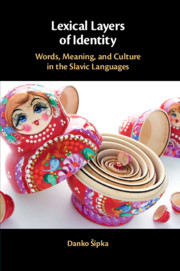
-
Select format
-
- Publisher:
- Cambridge University Press
- Publication date:
- May 2019
- May 2019
- ISBN:
- 9781108685795
- 9781108492713
- 9781108716963
- Dimensions:
- (228 x 152 mm)
- Weight & Pages:
- 0.52kg, 282 Pages
- Dimensions:
- (229 x 152 mm)
- Weight & Pages:
- 0.416kg, 286 Pages
You may already have access via personal or institutional login
Book description
Focusing on Slavic languages, Danko Šipka provides a systematic approach to lexical indicators of cultural identity. In contrast to existing research, which focuses heavily on syntactic and phonological approaches, Šipka's approach is novel, more systematic and encompassing, and postulates three lexical layers of cultural identity: deep, exchange, and surface. The deep layer pertains to culture-specific words, divisions, and features that are generally not subject to change and intervention. The exchange layer includes lexical markers of cultural influences resulting from lexical borrowing, which situates the speakers into various cultural circles. This layer is subject to gradual changes and some limited level of intervention from linguistic elites is possible. Finally, the surface layer encompasses the processes and consequences of lexical planning. It is subject to abrupt changes and it is shaped in constant negotiation between linguistic elites and general body of speakers.
Contents
-
Part V - Synthesis
pp 209-229 -
-
- You have access
- HTML
- Export citation
-
-
13 - Interaction between the Layers
pp 211-216 -
-
- You have access
- HTML
- Export citation
-
-
14 - Main Findings
pp 217-223 -
-
- You have access
- HTML
- Export citation
-
-
15 - An Outlook
pp 224-229 -
-
- You have access
- HTML
- Export citation
-
Metrics
Altmetric attention score
Full text views
Full text views help Loading metrics...
Loading metrics...
* Views captured on Cambridge Core between #date#. This data will be updated every 24 hours.
Usage data cannot currently be displayed.
Accessibility standard: Unknown
Why this information is here
This section outlines the accessibility features of this content - including support for screen readers, full keyboard navigation and high-contrast display options. This may not be relevant for you.
Accessibility Information
Accessibility compliance for the PDF of this book is currently unknown and may be updated in the future.


